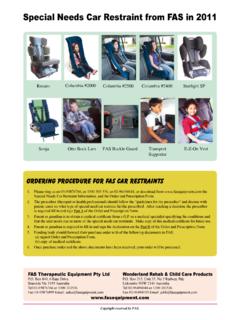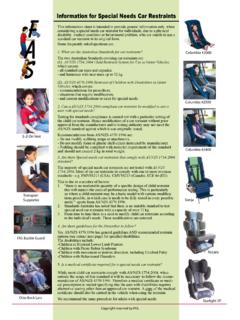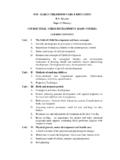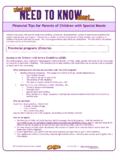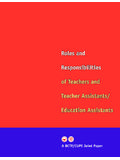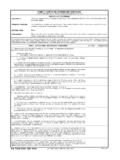Transcription of Information for Special Needs Car Restraints
1 Information for Special Needs Car Restraints This Information sheet is intended to provide general Information only, when considering a Special Needs car restraint for individuals, due to a physical disability, medical condition or behavioural problem, who are unable to use a standard car restraint in its original form. Some frequently asked questions are: 1. What are the Australian Standards for car Restraints ? Columbia #2000. The two Australian Standards covering car Restraints are: (1). AS/NZS 1754:2004 Child Restraint System for Use in Motor Vehicles, which covers: - all standard car seats and capsules, - and harnesses with user mass up to 32 kg. (2). AS/NZS 4370:1996 Restraint of Children with Disabilities in Motor Vehicles, which covers: - recommendations for prescribers, - situations that require modification, - and custom modifications to cater for Special Needs . Columbia #2500.
2 2. Can a AS/NZS 1754:2004-compliant car restraint be modified to suit a user with Special Needs ? Testing for standards compliance is carried out with a particular setting of the child car restraint. Hence modification of a car restraint without prior approval from the manufacturer and/or testing authority may not meet the AS/NZS standard against which it was originally tested. E-Z-On Vest Recommendations from AS/NZS 4370:1996 are: - Do not modify webbing straps or attachments. - Do not modify foam or plastic shell unless instructed by manufacturer. - Padding should be complied with material requirement of the standard and should not exceed 2 kg in total weight. Columbia #2400. 3. Are there Special - Needs car Restraints that comply with AS/NZS 1754:2004. standard? The majority of Special Needs car Restraints are not tested with AS/NZS. 1754:2004. Most of the car Restraints do comply with one or more overseas standards - FMVSS213 (USA), CMVSS213 (Canada), ECE 44 (EU).
3 This is due to a number of factors: 1. "there is no marketable quantity of a specific design of child restraint that will sustain the costs of performance testing. This is particularly Transport so where a child restraint may be a basic model with various modifica- tions possible, in which case it Needs to be fully tested in every possible Supporter Sonja mode." -quote from AS/NZS 4370:1996. 2. Standards Australia has noted that there is no suitable standard to test Special need car Restraints with a capacity of over 32 kg. 3. From time to time there is a need to modify child car Restraints according to the individual's Needs . These modifications are untested. 4. Are there guidelines for the Prescriber to follow? Yes. AS/NZS 4370:1996 has general guidelines AND recommended restraint FAS Buckle Guard options (see extract next page) for specified disabilities. The disabilities include: -Children in Bilateral Lower Limb Plasters -Children with Pierre Robin Syndrome -Children with movement or posture disorders, including Cerebral Palsy Recaro -Children with Behavioural Disorders 5.
4 Is a medical certificate required for a Special Needs car restraint? While most child car Restraints comply with AS/NZS 1754:2004, when outside the scope of this standard it will be necessary to follow the recom- mendation of AS/NZS 4370:1996. Therefore a medical certificate or medi- cal prescription is needed specifying that the user with disabilities requires alternative seating other than an approved car restraint. A copy of the medical certificate should also be carried in the vehicle when using the restraint. Otto Bock Lars We recommend the same procedure for adults with Special Needs . Starlight SP. Copyright reserved by FAS. General Guidelines For The Prescriber (Extract from AS/NZS 4370:1996, pgs 5-6). In prescribing the way in which a person should be restrained while travelling in a motor vehicle, the following should be observed: The first consideration for restraining a person should be through the use of Restraints that comply with the AS/NZS.
5 1754:2004, and vehicle seat belts which comply with relevant standards and regulations. The prescriber should become familiar with all aspects of the person's physical and psychological status and lifestyle. The Prescriber should advise the carer of the child: (1) Whether the child restraint complies with AS/NZS 1754:2004. (2). Whether the child restraint has been modified and to what extent. (3) Whether any other options have been considered but are not acceptable or possible. The prescriber should ensure that the installation and use of the restraint option is demonstrated to the carer/s. This should include advice that: a. The restraint or recommend method of transporting the person should not be changed without further advice being sought from the prescriber. b. The restraint and the installation of the restraint should be maintained in good order. c. The Carer/s should check that the restraint is fastened and correctly adjusted for each person on each journey.
6 A record should be kept of recommendations and action. Records should be maintained and updated when reviewing the restraint and when developing options for the restraint. This serves several purposes, including: a. Providing evidence that due care was taken in making recommendation for the person's restraint and that every endeavour was made to ensure that the best available protection was recommend. b. As a record of a solution to the problem in transporting a person with Special Needs . The carer/s of the person should be advised that the restraint must only be used to transport the person for whom it was recommended. The carer/s should follow the manufacturer's instructions for installation and use. Further Information & Resources 1. VicRoads, Child Restraints for Children with a Disability, June, 2011, -Web link: 2. Kidsafe Child Car Restraint Fact Sheet (WA). 3. Royal Children's Hospital, Melbourne (2000) Restraint of children with disabilities in motor vehicles.
7 -Web link: 4. Westmead Children Hospital Sydney -Guideline for transporting children with Special Needs . (April 2006). 5. TranSPOT Transport Safety Guidelines for People with Disability 2010 (CD). 6. Murdoch Children's Research Institute, Restraint of Children with Additional Needs in Motor Vehicles: Knowledge and challenges of Paediatric Occupational Therapists in Victoria, 2010. 7. Standards Australia, Child restraint systems for use in motor vehicles (AS/NZS 1754:2004). 8. Standards Australia, Restraint of children with disabilities in motor vehicles (AS/NZS 4370:1996). 9. Victoria Department of Human Services, Aids & Equipment Program guidelines and forms. -Web link: FAS Therapeutic Equipment Pty Ltd Wonderland Rehab & Child Care Products Box 840, 6 Bate Drive Box 215, Unit 35, No 2 Railway Pde Braeside Vic 3195 Australia Lidcombe NSW 2141 Australia Tel 03-95876766 or 1300 303536 Tel 02-96494044 or 1300 303536.
8 Fax 03-95876899 Email: Fax 02-96494055 Email: Copyright reserved by FAS.
